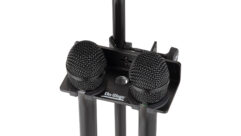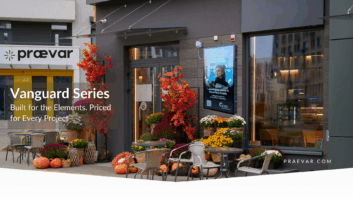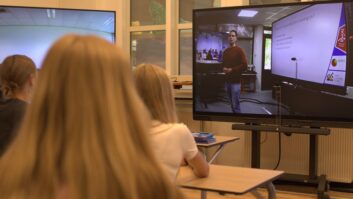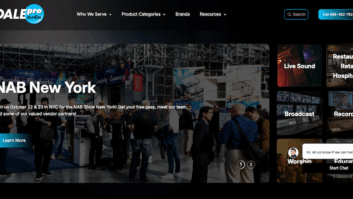

Studio design consultancy White Mark Ltd played an important role in creating a new Foley studio for Russia’s state of the art film sound facility CineLab Ltd. Unashamedly designed to be the best in the world, CineLab’s Foley studio is already attracting projects from both local and international clients.
Based in Moscow and housed in a completely renovated former cold store building on the banks of the Moskva River, CineLab already has 14 studios including three dubbing theatres, a 5.1 mixing room for pre-mixes and TV/DVD work, multiple edit and pre-production suites and sound design rooms. Three of CineLab’s dubbing theatres have Dolby Premier Licenses, and one of these was recently upgraded by White Mark to Dolby Atmos 3D spec.
The facility’s new Foley studio was designed to cater for two very distinctive approaches to Foley recording, says CineLab’s Managing Director Vadim Nerukov.
“Some Foley artists want to close mic everything and then add effects, compression, reverb, etc. afterwards in the control room,” he explains. “Others prefer a more ‘naturalistic’ approach where they use the space and air in the room and real reflections from the walls. In our opinion neither approach is the best – they are simply different. We wanted a room that could cope with both.”
To achieve this result, White Mark worked closely with internationally acclaimed and award-winning Foley artist and sound designer Nicolas Becker, whose credits include Harry Potter and the Goblet of Fire, The Ninth Gate, The Pianist, Oliver Twist, The Ghost and Venus In Furs, all directed by Roman Polanski.
White Mark’s managing director, David Bell says: “We designed and built the room from scratch, including every conceivable kind of indoor and outdoor surface. We also incorporated motorized ceiling panels and wall curtains that can be used to modify the room acoustics, and a special floor mounted on acoustic pads that can be tuned to different frequencies by tightening or loosening screws.
Bell adds that White Mark obviously included a conventional control room in its design but after speaking to Becker and watching him work, the company also positioned an additional mixing and recording area in the centre of the live room with a line of sight into each of the studio’s four working zones.
“This dedicated space allows the artists like Nicolas who prefer to work naturally to move around the studio and create sounds to the picture in real time,” David Bell says. “The picture is projected onto screens and the engineer working with him has five microphone positions at his disposal and can literally mix live, building up each scene, sound by sound.”
White Mark installed a 5.1 surround sound system in the Control Room, while the live room, which has four screens in different positions, has a theatrical-style loudspeaker system (Left-centre-Right) behind the main screen. This allows the Foley artist to work to picture and hear exactly what a cinema audience will ultimately hear.
Naturally the studio is filled with props and devices to create new sounds – and there is a dedicated large storage room with a car access dock so that bigger props can be brought in.
“This is, without doubt, the most impressive Foley room I’ve ever seen – and certainly the most impressive we’ve ever built,” David Bell adds. “Of course, having carte blanche to create something special did help – as did the fact that CineLab was effectively built from the ground up so we could incorporate features like the very thick cast concrete floor, incorporating deep pits and water pools of different depths, and the loading dock very early on in the design process.”
Vadim Nerukov says that completing CineLab’s Foley studio involved the most innovation in terms of ideas, design and workflow.
“As our design partner, White Mark has achieved great results with all of the rooms in the facility,” Nerukov says. “In our view they are the best acoustic design company on the market and we’re thrilled with the Foley room – it is quite simply magnificent.”
Recent projects undertaken at CineLab include the mix for the feature film Stalingrad, carried out by Vincent Arnardi, and the mix for Viy, carried out by four times Oscar winning sound engineer Bob Beemer. CineLab has also recently completed the Russian dub of The Amazing Spiderman 2, one of the first projects to take place in its newly accredited Dolby Atmos theatre.
-ends-
About White Mark:
Established in 1997 by David Bell, John Dunnill, Derek Buckingham and Alan Cundell, White Mark Ltd specialises in production facilities for music recording and the film and television industries. Over the last fifteen years it has designed and supervised the construction of over 500 production suites worldwide. The company’s impressive client list encompasses some of the world’s most famous music recording facilities including Peter Gabriel’s Real World Studios in the UK, Germano Studios in New York, Hit Factory/Criteria Recording Studios in Miami, Strongroom in London and private studios for producers and musicians such as William Orbit and Damon Albarn. In the area of audio post production, White Mark has completed over 140 audio studios and many broadcast and video editing facilities for more than 60 companies in Soho alone. The list of clients includes Grand Central, Hackenbacker, Envy, De Lane Lea, Scramble, Lipsync, Molinare, DeLuxe, 750mph, NBC/Universal, Wave, Unit and Boom. Advertising agency clients include worldwide facilities for Hogarth International and AMV/BBDO on four continents.










